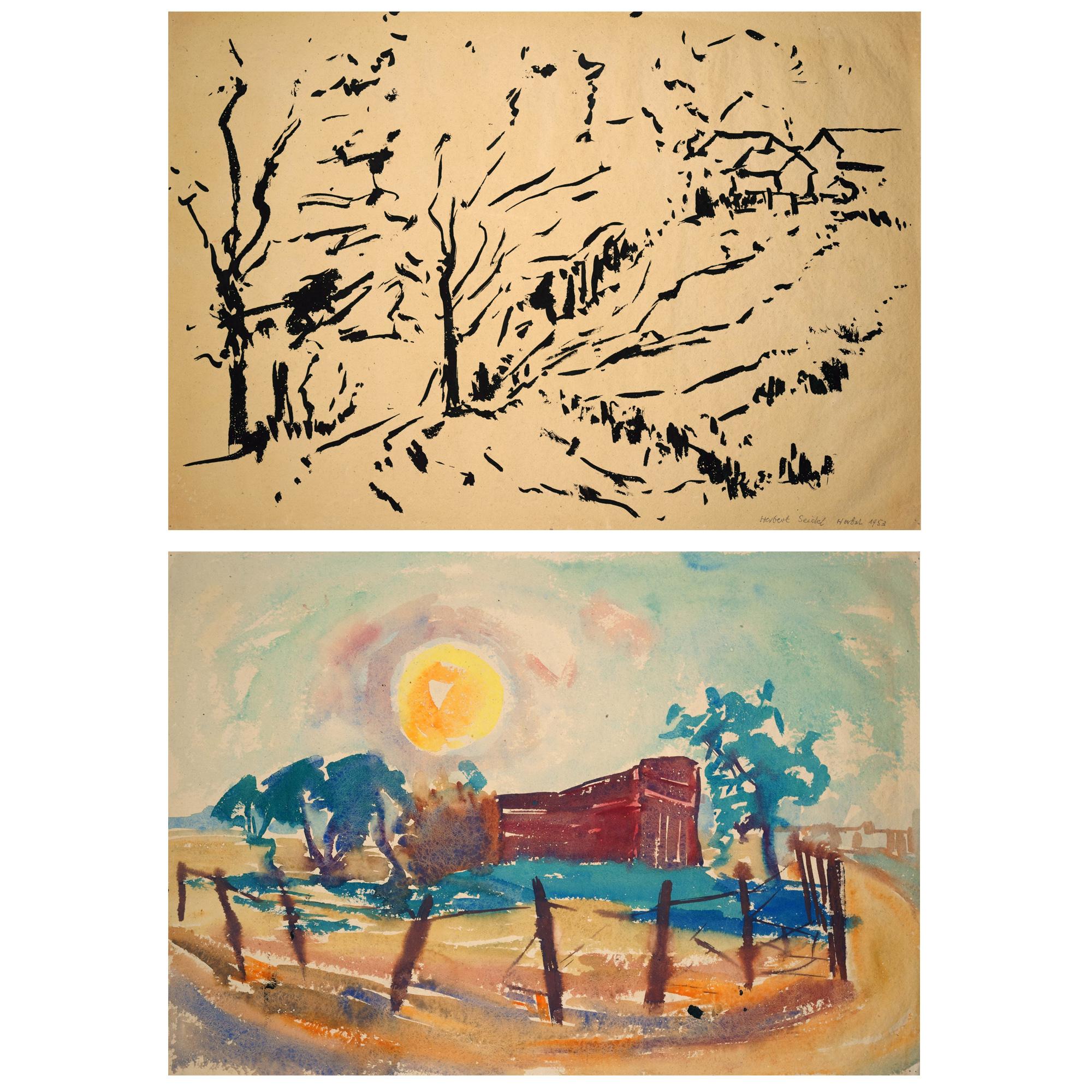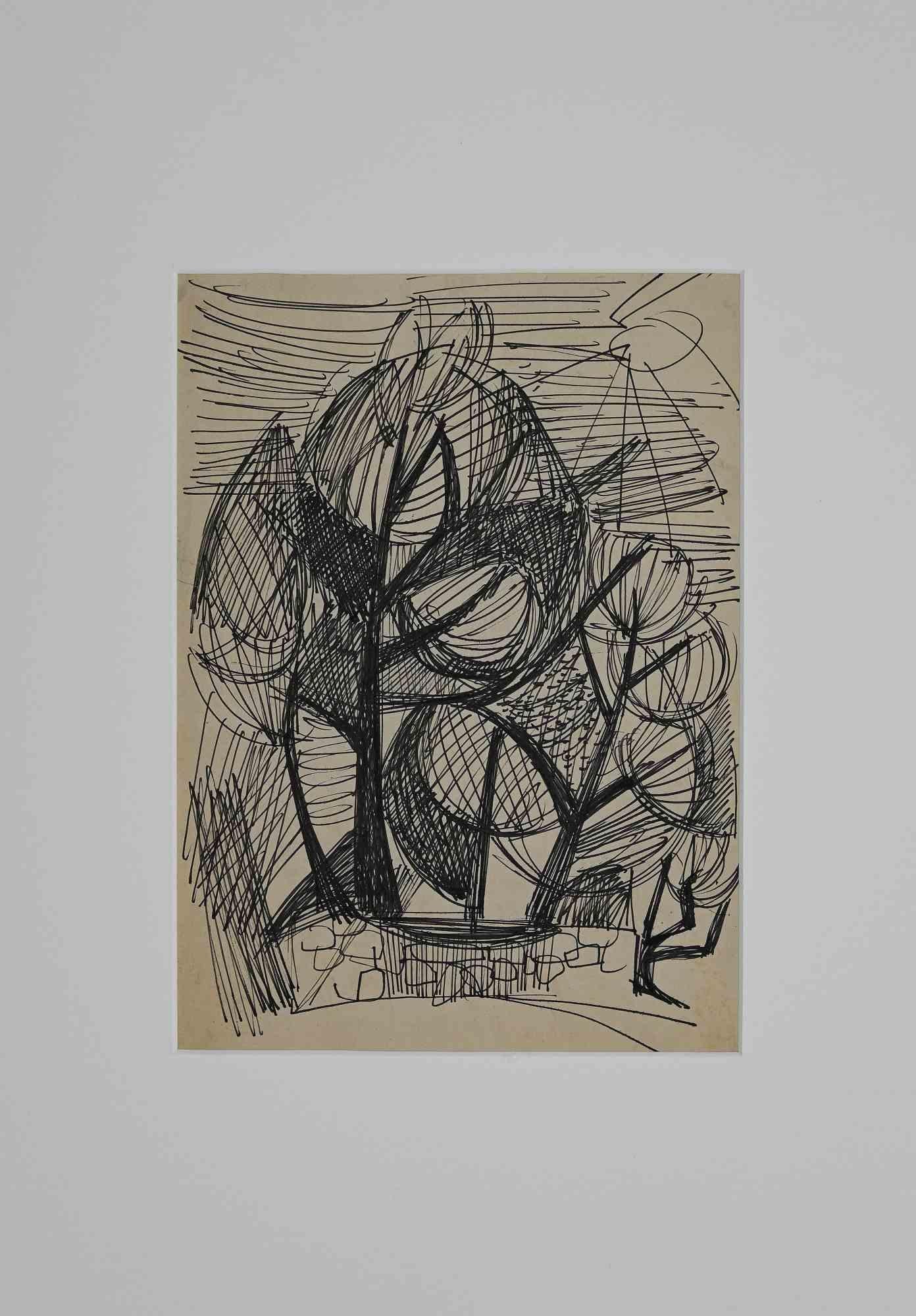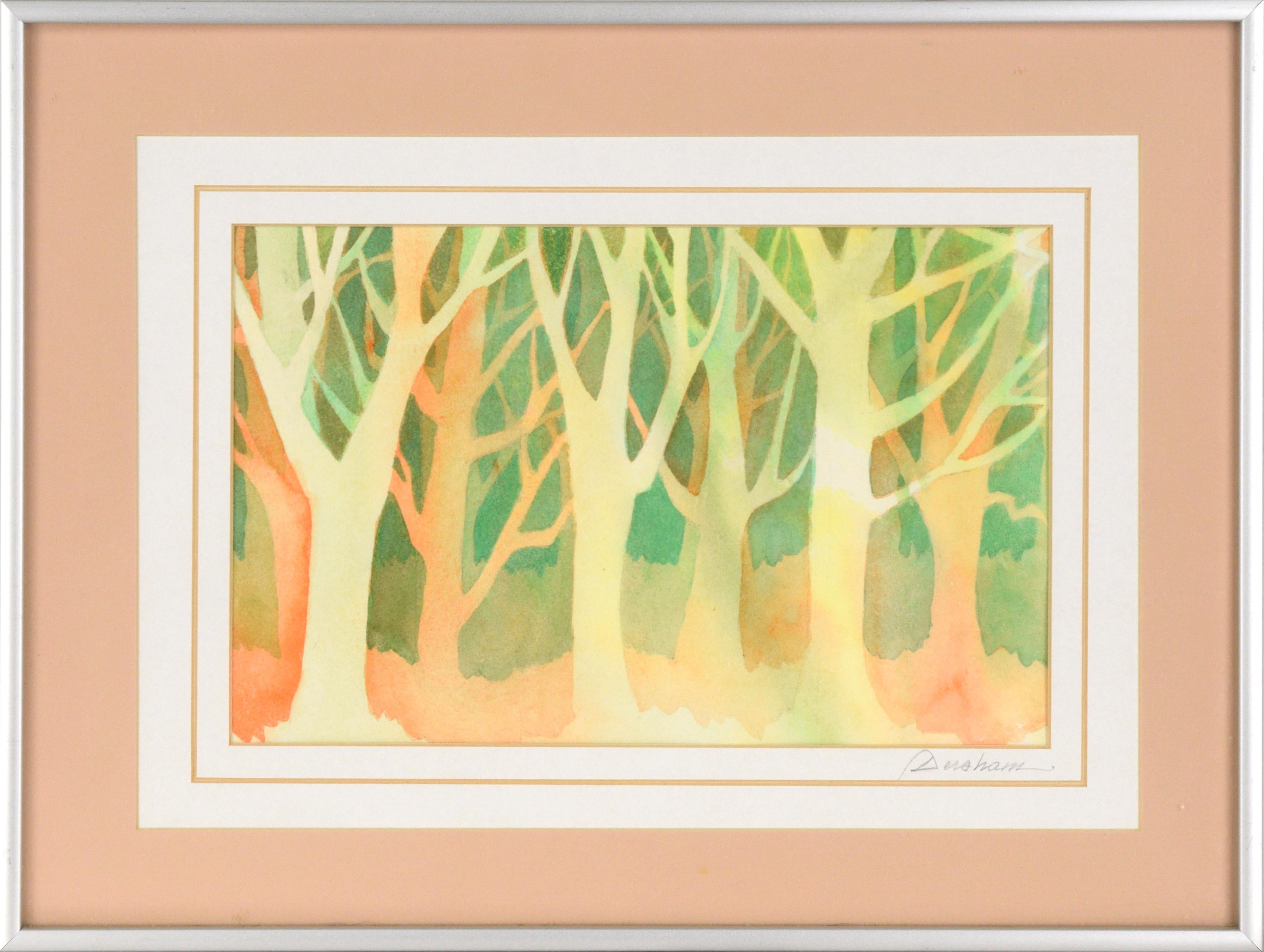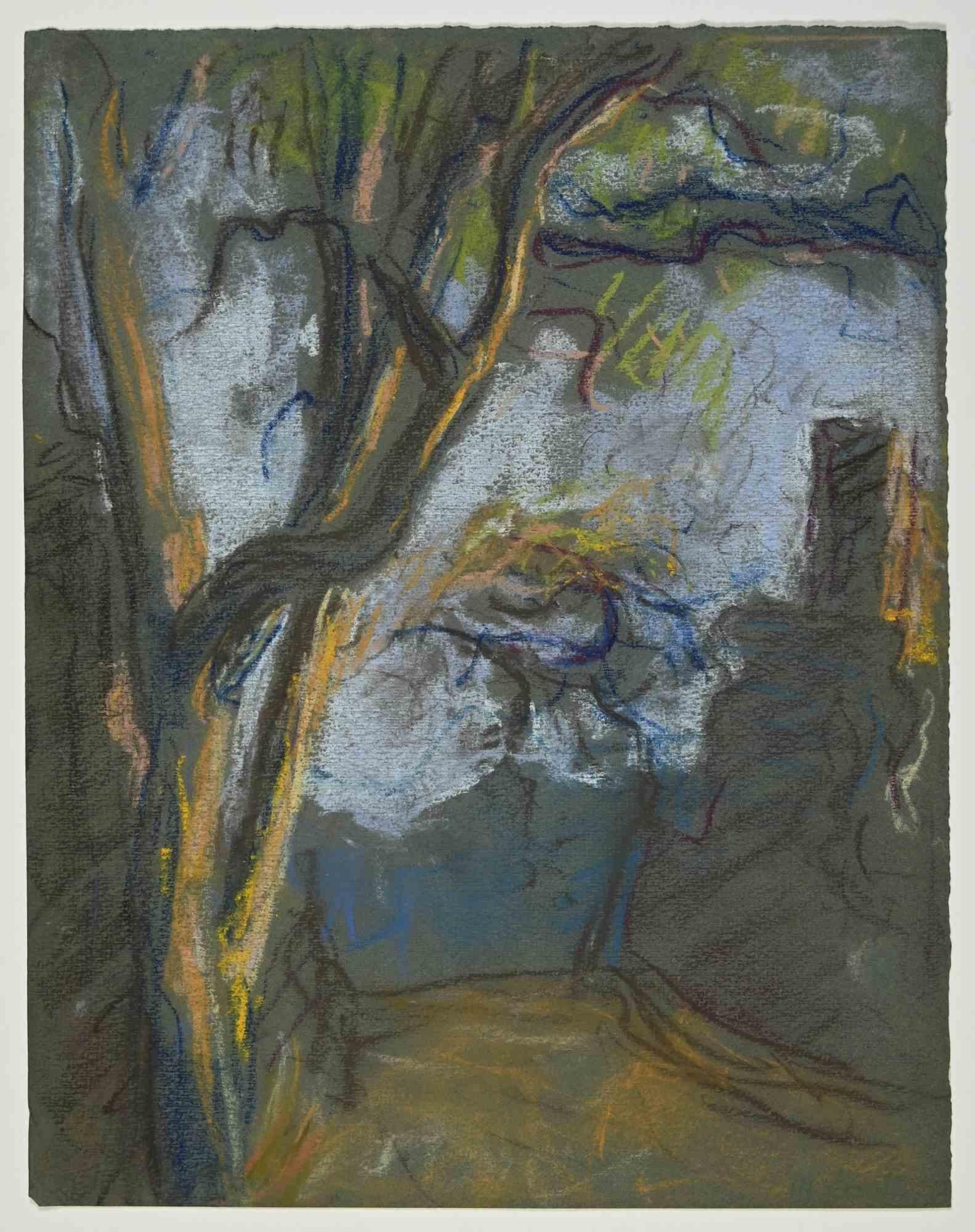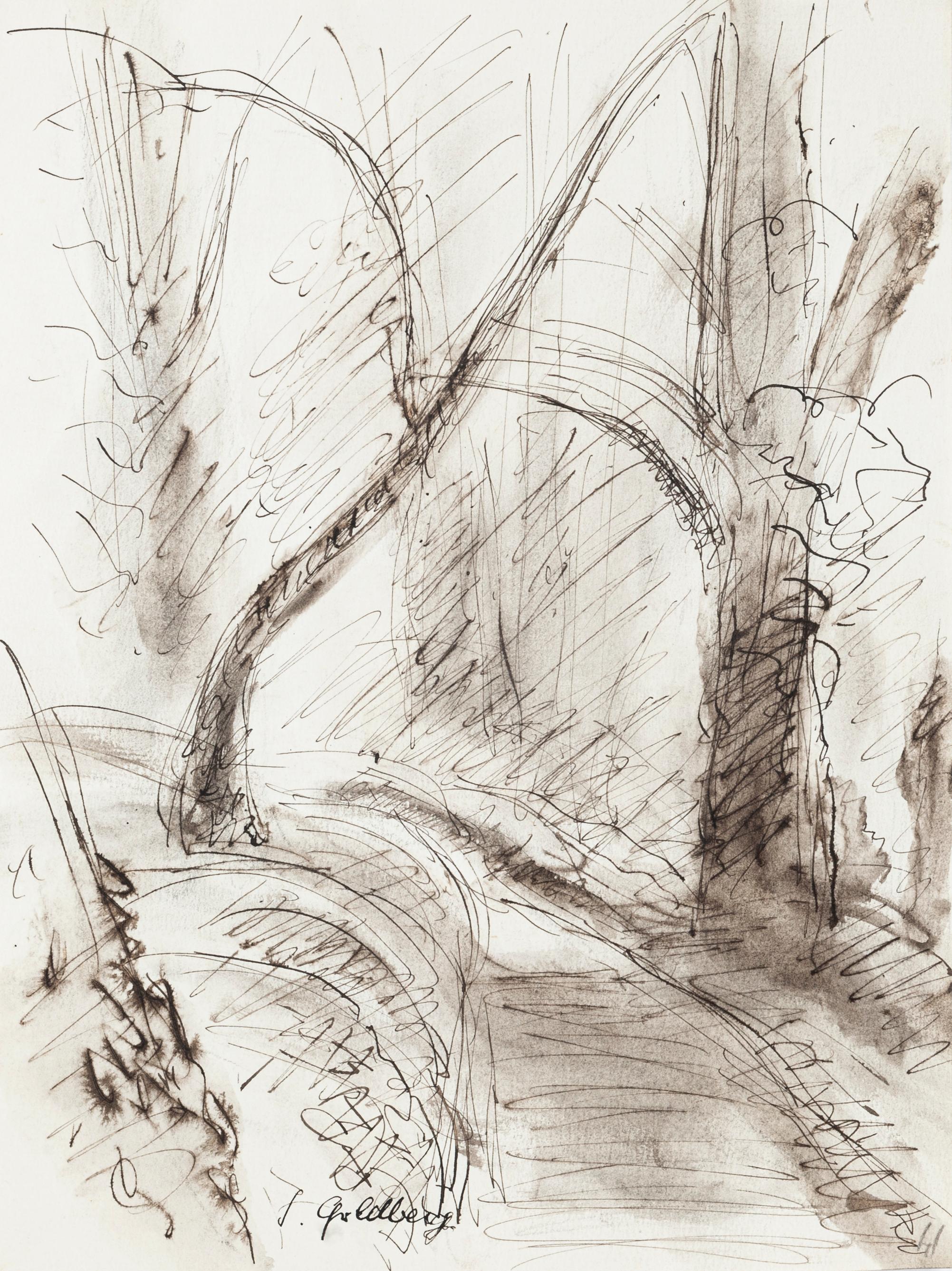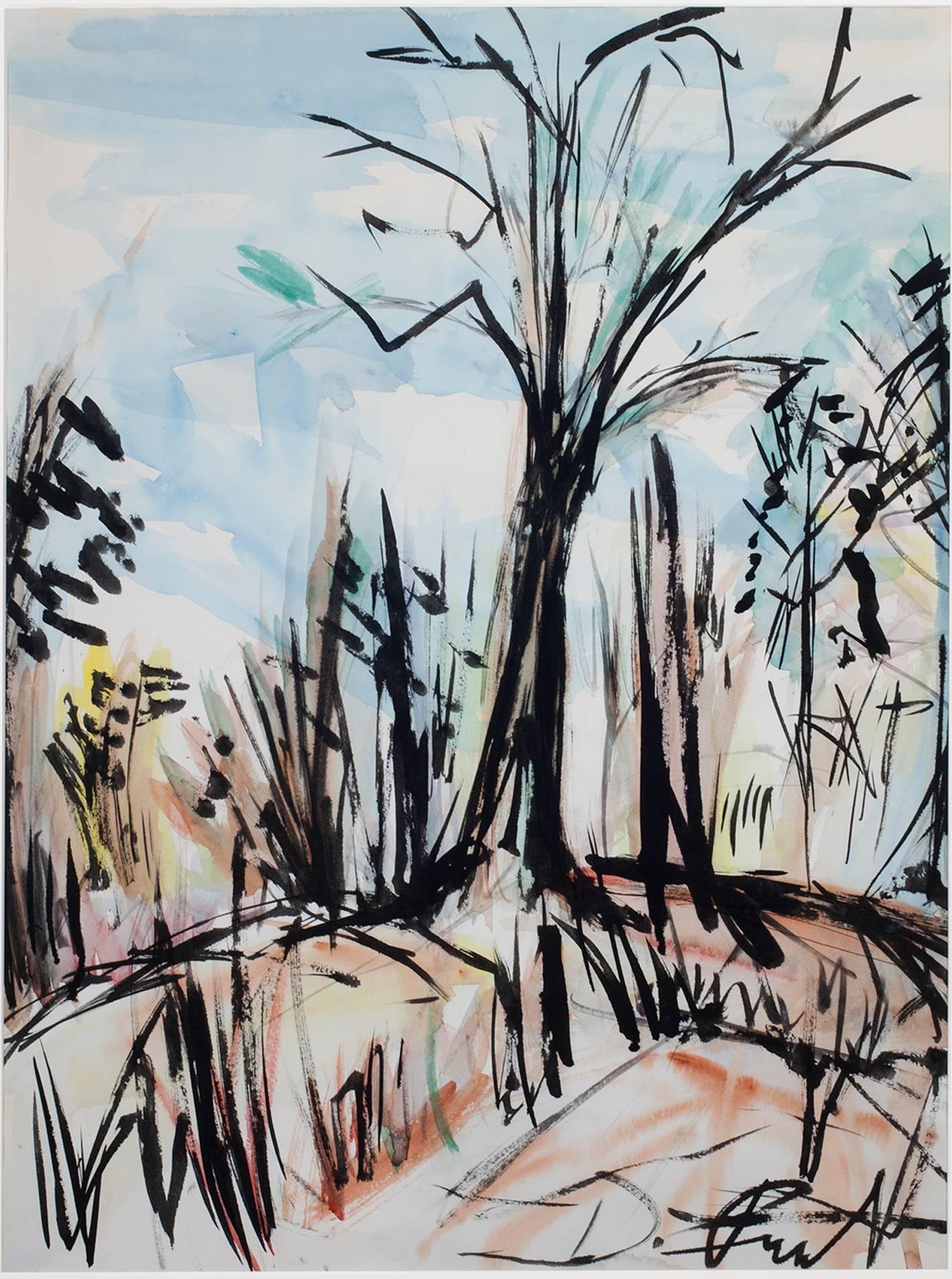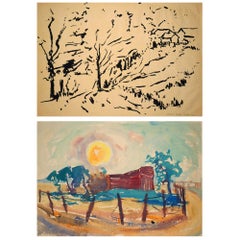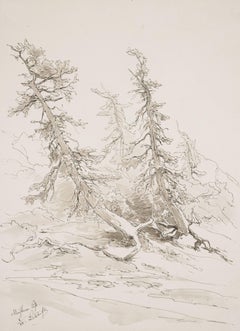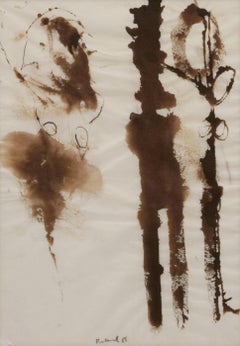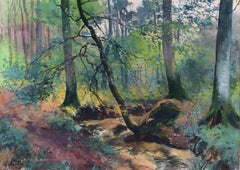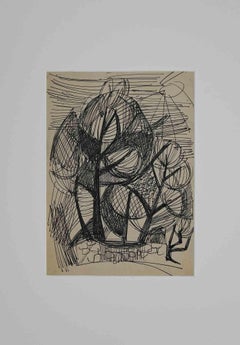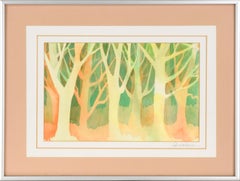Items Similar to Landscape verso Forest interior / - Landscape as a space of imagination -
Want more images or videos?
Request additional images or videos from the seller
1 of 13
Herbert SeidelLandscape verso Forest interior / - Landscape as a space of imagination -
$455.14
£337.28
€380
CA$621.35
A$691.23
CHF 362.35
MX$8,446.67
NOK 4,614.10
SEK 4,343.54
DKK 2,893.29
Shipping
Retrieving quote...The 1stDibs Promise:
Authenticity Guarantee,
Money-Back Guarantee,
24-Hour Cancellation
About the Item
Herbert Seidel (1906 Berlin - 1974 Rüdersdorf), Landscape verso Forest interior, around 1950. India ink on grained, bleached paper, 40.5 x 58 cm, signed “Herbert Seidel” in pencil on the front and inscribed “Landschaft”.
- Pinholes in the corners, slight creases and minimally wavy
- Landscape as a space of imagination -
As a master of woodcut, Herbert Seidel was inspired by the aesthetic effect of this technique for his paintings. The broad black strokes look like the lines of a woodcut, although the line structures are much more expressive here, as in letterpress woodcuts the areas formed by the cut wood are printed. Nevertheless, the black lines in particular echo the effect of the woodcut, and the forms of the trees, houses, landscapes and mountains, which are only outlined, are based on the pictorial idea of the woodcut.
By making the artistic experience of the woodcut fruitful for painting, an extremely expressive landscape is created, which we complete with our eyes and thus open up imaginatively.
At the back is a forest aisle, crisscrossed by glowing red trunks, leading to a turquoise light at the end. The trees look like the nave of a Gothic cathedral and recall Johann Wolfgang Goethe's comparison of the interior of Strasbourg Cathedral to a forest. It is precisely this association with a naturally grown sacred building that Herbert Seidel seems to take up here in his formation of a new sacred art.
About the artist
Herbert Seidel was a German painter and printmaker best known for his woodcuts of Christian themes. Taking modernism as his starting point, he sought to revive sacred imagery. At the same time, he distinguished himself with innovative landscape painting.
GERMAN VERSION
Herbert Seidel (1906 Berlin - 1974 Rüdersdorf), Landschaft verso Waldinneres, um 1950. Tusche auf genarbtem geblichen Papier, 40,5 x 58 cm, vorderseitig in Blei mit „Herbert Seidel“ signiert und als „Landschaft“ bezeichnet.
- An den Ecken Nadellöcher, leichte Knickspuren und minimal gewellt
- Landschaft als Imaginationsraum -
Als Meister des Holzschnitts lässt sich Herbert Seidel von der ästhetischen Wirkung dieser Technik für seine Malerei inspirieren. Die breiten schwarzen Striche wirken wie Lineaturen eines Holzschnitts, wobei die Liniengefüge hier weit expressiver sind, da beim Hochdruckverfahren des Holzschnitts die durch das weggeschnittene Holz geformten Flächen gedruckt werden. Dennoch greifen gerade die schwarzen Lineaturen die Wirkung des Holzschnitts auf und den einzig in Umrissen angedeuteten Formen der Bäume, Häuser, Landschaftsgründe und Berge liegt das bildnerische Denken des Holzschnitts zugrunde.
Durch die Fruchtbarmachung der künstlerischen Erfahrung mit dem Holzschnitt für die Malerei entsteht eine äußerst expressiv wirkende Landschaft, die wir mit dem Auge ergänzen und dadurch imaginativ erschließen.
Rückseitig ist eine von glühend roten Stämmen durchzogene Waldschneise zu sehen, die am Ende auf ein türkisfarbenes Licht zuläuft. Die Bäume wirken wie das Mittelschiff einer gotischen Kathedrale und erinnern an Johann Wolfgang Goethes Vergleich des Inneren des Straßburger Münsters mit einem Wald. Eben diese Assoziation eines natürlich gewachsenen Sakralbaus scheint Herbert Seidel hier bei seiner Formierung einer neuen sakralen Kunst aufzugreifen.
zum Künstler
Herbert Seidel war ein deutscher Maler und Grafiker, der vor allem durch seine Holzschnitte christlicher Themen Bekanntheit erlangte. Dabei versuchte er, von der Moderne ausgehend, die sakrale Bildsprache zu revitalisieren. Gleichzeitig tat er sich mit einer innovativen Landschaftsmalerei hervor.
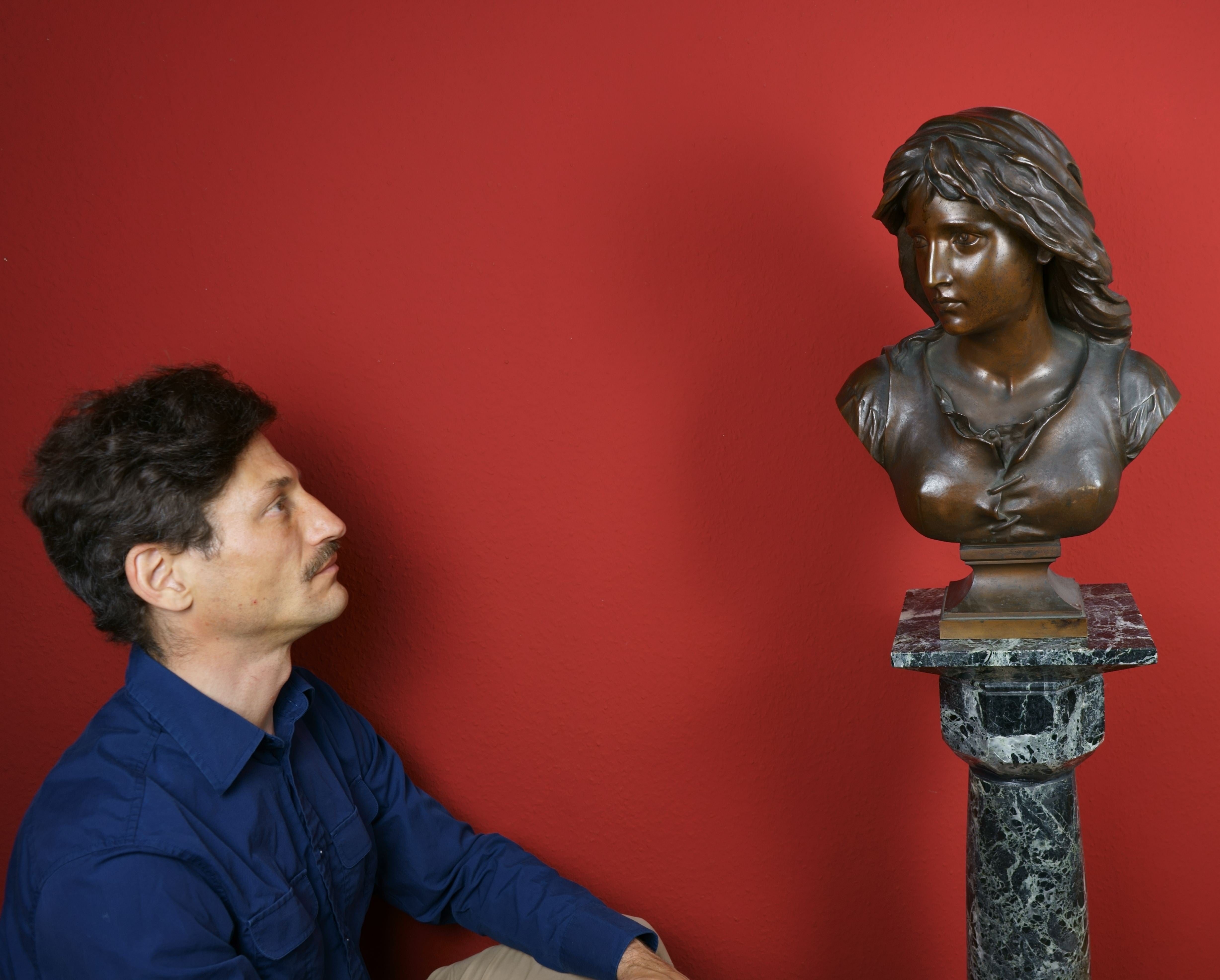
About the Seller
5.0
Gold Seller
Premium sellers maintaining a 4.3+ rating and 24-hour response times
Established in 2014
1stDibs seller since 2023
20 sales on 1stDibs
- ShippingRetrieving quote...Shipping from: Berlin, Germany
- Return Policy
Authenticity Guarantee
In the unlikely event there’s an issue with an item’s authenticity, contact us within 1 year for a full refund. DetailsMoney-Back Guarantee
If your item is not as described, is damaged in transit, or does not arrive, contact us within 7 days for a full refund. Details24-Hour Cancellation
You have a 24-hour grace period in which to reconsider your purchase, with no questions asked.Vetted Professional Sellers
Our world-class sellers must adhere to strict standards for service and quality, maintaining the integrity of our listings.Price-Match Guarantee
If you find that a seller listed the same item for a lower price elsewhere, we’ll match it.Trusted Global Delivery
Our best-in-class carrier network provides specialized shipping options worldwide, including custom delivery.More From This Seller
View AllAutumn verso Summer Landscape / - Imagined Landscape -
Located in Berlin, DE
Seidel, Herbert (1906-1974), Autumn verso Summer Landscape, 1953
Herbert Seidel (1906 Berlin - 1974 Rüdersdorf), Autumn verso Summer Landscape, 1953. India ink on grained, bleached p...
Category
1950s Abstract Landscape Drawings and Watercolors
Materials
Paper
Woodland / - The Inner Drama of the Landscape -
Located in Berlin, DE
Eduard Peithner von Lichtenfels (1833 Vienna - 1913 Berlin), Woodland, 1884. Watercolor and pen and ink on drawing paper, 30.4 cm x 22.5 cm, signed, dated and inscribed by the artist...
Category
1880s Landscape Drawings and Watercolors
Materials
Paper
Untitled / - Association -
Located in Berlin, DE
Detlef Baltrock (*1954 Stuttgart), Untitled, 1985. Watercolor, 29.5 cm x 21 cm (visible dimensions), 41 cm x 32 cm (frame), signed “Baltrock” lower center and signed “[19]85”, label ...
Category
1980s Abstract Expressionist Abstract Drawings and Watercolors
Materials
Paper
Summer Forest Landscape, 1915 / - The Forest Walk -
Located in Berlin, DE
Stanislas Warnie (1879-1958), Summer Forest Landscape, 1915. Watercolor, 31.5 cm x 45 cm (passepartout), 50.5 cm x 63.5 cm (frame), signed "S. Warnie" at lower left and dated "1915"....
Category
1910s Art Nouveau Landscape Drawings and Watercolors
Materials
Watercolor
$622 Sale Price
20% Off
Norwegian Pine Grove - The inner glow of the trees -
Located in Berlin, DE
Themistokles von Eckenbrecher (1842 Athens - 1921 Goslar), Norwegian pine grove, 1901. Watercolor on blue-green paper, 30 x 22 cm. Signed, dated and inscribed in his own hand "TvE. Fagermes [i.e. Fagermes]. 26.6.[19]01."
- Slight crease throughout at left margin, otherwise in good condition.
About the artwork
Themistokles von Eckenbrecher often traveled to Norway to study the nature that fascinated him there. On June 26, 1901, near the southern Norwegian town of Fagernes, in the summer evening sun, he saw a small pine grove, which he immediately captured in a watercolor. He exposed the trees growing on a small hill in front of the background, so that the pines completely define the picture and combine to form a tense motif. The tension comes from the contrast of form and color. The trunks, growing upward, form a vertical structure that is horizontally penetrated by the spreading branches and the pine needles, which are rendered as a plane. This structural tension is further intensified by the color contrast between the brown-reddish iridescent trunks and branches and the green-toned needlework.
Themistokles von Eckenbrecher, however, does not use the observed natural scene as an inspiring model for a dance of color and form that detaches itself from the motif and thus treads the path of abstracting modernism. Its inner vitality is to be brought to light and made aesthetically accessible through the work of art.
It is precisely in order to depict the inner vitality of nature that von Eckenbrecher chooses the technique of watercolor, in which the individual details, such as the needles, are not meticulously worked out, but rather a flowing movement is created that unites the contrasts. The trees seem to have formed the twisted trunks out of their own inner strength as they grew, creatingthose tense lineations that the artist has put into the picture. The inner strength continues in the branches and twigs, culminating in the upward growth of the needles. At the same time, the trunks, illuminated by the setting sun, seem to glow from within, adding an almost dramatic dimension to the growing movement.
Through the artwork, nature itself is revealed as art. In order to make nature visible as art in the work, von Eckenbrecher exposes the group of trees so that they are bounded from the outside by an all-encompassing contour line and merge into an areal unity that enters into a figure-ground relationship with the blue-greenish watercolor paper. The figure-ground relationship emphasizes the ornamental quality of the natural work of art, which further enforces the artwork character of the group of trees.
With the presentation of Themistokles von Eckenbrecher's artistic idea and its realization, it has become clear that the present watercolor is not a study of nature in the sense of a visual note by the artist, which might then be integrated into a larger work context, but a completely independent work of art. This is why von Eckenbrecher signed the watercolor. In addition, it is marked with a place and a date, which confirms that this work of nature presented itself to him in exactly this way at this place at this time. At the same time, the date and place make it clear that the natural work of art has been transferred into the sphere of art and thus removed from the time of the place of nature.
About the artist
Themistocles' parents instilled a life of travel in their son, who is said to have spoken eleven languages. His father, who was interested in ancient and oriental culture, was a doctor and had married Francesca Magdalena Danelon, an Italian, daughter of the British consul in Trieste. During a stay in Athens - Gustav von Eckenbrecher was a friend of Heinrich von Schliemann and is said to have given him crucial clues as to the location of Troy - Themistokles saw the light of day in 1842.
After an interlude in Berlin, where Themistokles was educated at the English-American School, the journey began again. From 1850 to 1857 the family lived in Constantinople, after which the father opened a practice in Potsdam, where Themistokles, who wanted to become a painter, was taught by the court painter Carl Gustav Wegener.
In 1861 the von Eckenbrechers left Potsdam and settled in Düsseldorf. There Themistokles received two years of private tuition from Oswald Aschenbach, who greatly admired the talented young artist. After his artistic training, he undertook extensive travels, often accompanied by Prince Peter zu Sayn-Wittgenstein, which took him to northern and eastern Europe, but above all to the Middle East and even to South America. The paintings that resulted from these journeys established his artistic reputation and led to his participation in large panoramas such as the 118 x 15 metre Entry of the Mecca Caravan into Cairo, painted for the City of Hamburg in 1882.
1882 was also the start of a total of 21 study trips to Scandinavia, most of them to Norway, and the unique Norwegian landscape with its rugged fjords became a central motif in his work. Along with Anders Askevold and Adelsteen Normann...
Category
Early 1900s Naturalistic Landscape Drawings and Watercolors
Materials
Watercolor
$1,149 Sale Price
20% Off
Rare Animal / - Abstract figuration -
Located in Berlin, DE
Veit Hofmann (*1944 Dresden), Rare Animal, 1987. Oil on light card, 42 cm (height) x 30 cm (width), monogrammed “V[eit]H[ofmann]” lower right and dated “[19]87”, titled “Seltenes Tie...
Category
1980s Abstract Expressionist Abstract Paintings
Materials
Oil
You May Also Like
Landscape with Trees - Original Drawing - 1950s
Located in Roma, IT
Landscape with trees is an original china ink drawing realized by Unknown Artist in 1950s.
The artwork represent a beautiful landscape.
Good condition, so signature, mounted on a w...
Category
1950s Modern Figurative Drawings and Watercolors
Materials
Ink
Abstracted Forest Landscape
Located in Soquel, CA
Brightly colored abstract forest by unknown artist Dersham (20th Century). The trees in this piece are light in color, standing out from the saturated background. Multiple layers of ...
Category
Late 20th Century American Modern Landscape Drawings and Watercolors
Materials
Paper, Watercolor
$280 Sale Price
20% Off
Landscapes - Drawing by Suzie Bernardeau - 20th century
Located in Roma, IT
Landscapes is an artwork made by Suzie Bernardeau during the 20th century.
Pastel drawing.
Signed.
Good condition.
Category
20th Century Modern Figurative Drawings and Watercolors
Materials
Pastel
Forest - Ink and Watercolor by S. Goldberg - 1950s
By Simon Goldberg
Located in Roma, IT
Forest is an original drawing in mixed media on paper realized by Simon Goldberg (1913-1985). Hand-signed on the lower left.
The state of preservation is very good.
Sheet dimension...
Category
1950s Contemporary Landscape Drawings and Watercolors
Materials
Ink, Watercolor
"Trees, " Watercolor Painting of a Winter Scene signed by David Barnett
By David Barnett
Located in Milwaukee, WI
"Trees" is an original watercolor by David Barnett. It depicts some dark leafless trees and shrubs. The artist signed the piece lower right.
24" x 18" art
29 1/4" x 23 1/4" frame
...
Category
1960s Expressionist Landscape Drawings and Watercolors
Materials
Watercolor
Landscape - Drawing by Leo Guida - 1968
By Leo Guida
Located in Roma, IT
Landscape is an original artwork realized in 1968 by the italian Contemporary artist Leo Guida (1992 - 2017).
Original pastels drawing on ivory-colored paper, glued on cardboard ...
Category
1960s Contemporary Figurative Drawings and Watercolors
Materials
Pastel
More Ways To Browse
Herbert Artist
Red Line Drawings
German Mountain Landscape
Watercolor Prints Trees
Interior Cathedral Paintings
Christian Dior 1950
Christian Dior 1959
Line Drawings Male
Art Aisle
Vintage Hauser
Johann Wolfgang Von Goethe
Vintage Tat
Strasbourg Cathedral
Pam Hassler
Panos Ghikas
Paul Braddon
Peter Lipman Wulf
Phil Wildman
